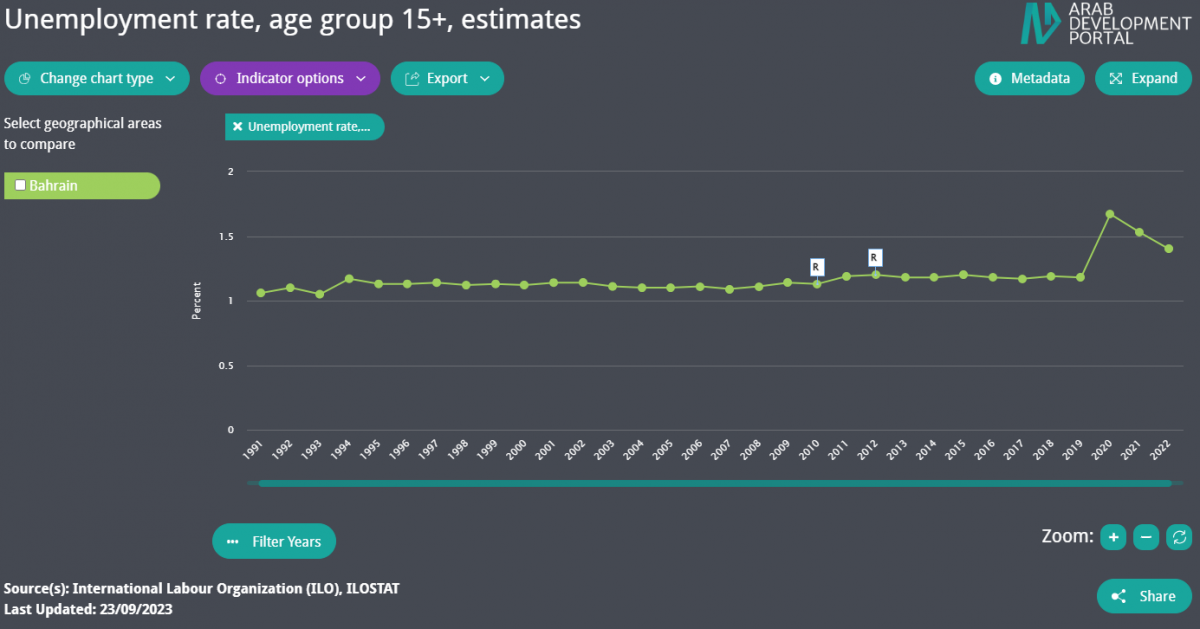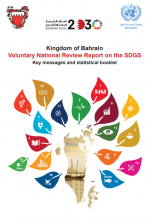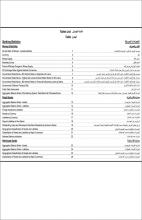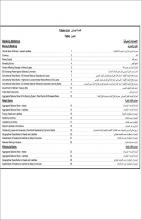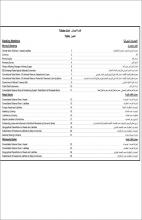 Bahrain
Bahrain
An island country, Bahrain is the least populous country in the Gulf Cooperation Council (GCC), estimated at 1.48 million and growing at an average of 4.3 percent in the last decade.[1] Like all other GCC countries, Bahrain’s population is largely urbanized, with 89.74 percent of its population living in urban areas.[2] Highly reliant on foreign labor, which reached 609,028 workers by the end of the second quarter of 2023, accounting for 79.08 percent of the country's total employment.[3] Bahrain has a migrant population of about 63.3 percent.[15]
The 2021 Human Development Index (HDI) for Bahrain is 0.875, positioning it in the very high human development group – ranking 35th out of 191 countries and territories. Bahrain’s HDI has increased by 17.9 percent since 1990, owing to the progress in its indicators. Between 1990 and 2023, Bahrain’s life expectancy at birth increased by 8 years, and between 1990 and 2021 mean years of schooling increased by 5.9 years, expected years of schooling increased by 2.4 years, and Bahrain’s GNI per capita decreased by about 3.2 percent.[5]
Education prospects in Bahrain are positive as reflected by different indicators. The, gross enrolment ratio in primary schools registered 92.34 percent, and the children out-of-school, percent of primary school age at 2.34.[6][8] Similarly, Bahrain has achieved remarkable accomplishments in the health sector. With government health expenditure at 2.96 percent of GDP,[7] the kingdom is ranked third among the Arab countries in the Universal Health Coverage Index at 76 after UAE and Kuwait.[8]
In 2019, Bahrain adopted the highest number of regulatory reforms (nine), becoming one of the top 10 improvers out of 190 economies, improving in almost every area measured by World Bank’s 2020 Doing Business report. Bahrain’s efforts focused primarily on protecting minority investors, enforcing contracts, strengthening access to credit, implementing digital taxes payment and smoothing resolving insolvency. The kingdom is ranked second among the Arab countries in 2020.[9]
A minor player in the oil market, Bahrain produced 14.43 million barrels of crude oil in 2022, the least among the GCC countries.[4][10] In April 2018, Bahrain announced a huge discovery of offshore oil and gas of up to 80 billion barrels of oil.[10] Despite attempts to diversify, oil and gas constituted around 82.4 percent of total government revenues in 2018 which decreased to 68.2 in 2021,[4] and contributed to 17.1 percent of GDP in Q2 2023.[11]
With the plunge in international oil prices as of mid-2014, external and fiscal vulnerabilities have deepened in Bahrain. Despite an increase in real GDP growth rate in 2016 and 2017 at 3.2 and 3.9 percent, respectively, growth slowed down to 1.8 percent in 2018, mainly due to the contraction in the crude petroleum and natural gas sector, dropping to -1.3 percent, and slowdowns in real estate and business activities and hospitality sectors, which contracted by 0.6 and 1.1 percent. In 2019, hydrocarbon GDP growth returned to positive figure increasing by 2.2 percent, driven by slight incline in oil production, while non-oil GDP growth registered 1.7 percent down from 2.5 percent in 2018. As a result, the real GDP growth rate remained flat at 1.8 percent. However, the Kingdom recorded a 2.0% YoY real GDP growth in the second quarter of 2023. This growth was supported by a 2% increase in the non-oil sector and a 2.2% increase in the Oil sector. The Ministry of Finance and National Economy projects real GDP growth of 2.9% during 2023. This is expected to accelerate 3.2% in 2024.[11]
Despite the introduction of a 5 percent Value-added Tax (VAT) in January 2019, inflation has eased, at an average of 1 percent in 2019, reflecting weak domestic demand. Following a clear increase in price pressures during 2022, the Consumer Price Index has moderated markedly in 2022 and remained fairly steady.[11] Bahrain’s cash balance has been in deficit since 2009, peaking at -18.29 percent of GDP in 2015, and decreasing to -5.64 percent of GDP in 2022. This improvement in the fiscal balance followed the implementation of several reform measures announced by the authorities as part of the Fiscal Balance Program, launched in October 2018, and aims to address the Kingdom’s fiscal challenges over the medium term. Reforms included the introduction of the VAT, a voluntary retirement scheme for public sector workers, and a government-wide spending review and dedicated spending efficiency taskforces.[11] Persistent large fiscal deficits have led to a significant increase in the government debt, which reached 117.58 percent in 2022, up from 21.3 percent of GDP in 2009.[12]
The current account deficit has narrowed to -2.05 percent of GDP in 2019, down from -6.5 percent in 2018, driven by non-oil trade dynamics and small outflows of remittances In 2022, it increased recording 9.05 percent.[12] Bahrain’s economy remains highly dependent on trade, with a trade-to-GDP ratio amounting to 159.8 percent in 2021,[13] and with its main non-oil trading partners being Saudi Arabia, United Arab Emirates (UAE) and United States. More than one-third (35.6 percent) of Bahrain’s total non-oil exports are destined for two Arab countries, namely, Saudi Arabia (25.2 percent), and UAE (10.4 percent).[11]
According to ILO estimates, the unemployment rate decreased from 1.6 to 1.4 between 2020 and 2022. Women are disproportionately affected, with a 4.22 unemployment rate compared to 0.61 for men.[14]
This overview was last updated in October 2023. Priority is given to the latest available official data published by national statistical offices and/or public institutions.
Sources:
[1] Population Division of the Department of Economic and Social Affairs of the United Nations Secretariat. 2023. World Population Prospects. [ONLINE] Available at: https://population.un.org/wpp/ [Accessed 23 October 2023].
[2] Population Division of the Department of Economic and Social Affairs of the United Nations Secretariat. 2023. World Urbanization Prospects. [ONLINE] Available at: https://population.un.org/wup/ [Accessed 23 October 2023].
[3] Labor Market Regulatory Authority. 2023. Labor Market Indicators. [ONLINE] Available at: http://lmra.bh/portal/en/page/show/223 [Accessed 24 October 2023].
[4] Information and e-Government Authority. 2023. Bahrain Open Data Portal. [ONLINE] Available at: https://www.data.gov.bh/explore/?sort=modified [Accessed 25 October 2023].
[5] United Nations Development Programme (UNDP). 2023. Human Development Index. Country Profiles, Bahrain. [ONLINE] Available at: https://hdr.undp.org/data-center/documentation-and-downloads; https://hdr.undp.org/data-center/country-insights#/ranks [Accessed 25 October 2023].
[6] United Nations Educational, Scientific and Cultural Organization (UNESCO). UIS database. 2023. [ONLINE] Available at: http://data.uis.unesco.org/ [Accessed 15 October 2023].
[7] World Health Organization. 2023. Global Health Expenditure Database. [ONLINE] Available at: https://apps.who.int/nha/database/Select/Indicators/en [Accessed 15 October 2023].
[8] The World Bank. 2023. Sustainable Development Indicators. [ONLINE] Available at: https://databank.worldbank.org/source/sustainable-development-goals-(sdgs) [Accessed 23 August 2023].
[9] The World Bank. 2023. Doing Business database. [ONLINE] Available at: https://datacatalog.worldbank.org/search/dataset/0038564/Doing-Business [Accessed 25 October 2023].
[10] National Oil and Gas Authority. 2023 and April 2018. 80 BILLION BARRELS OF ‘OIL IN PLACE’ IDENTIFIED IN BAHRAIN. [ONLINE] Available at: http://www.noga.gov.bh/noga/news.aspx?id=2213; http://www.noga.gov.bh/moo/ar/OpenData.aspx [Accessed 25 October 2023].
[11] Kingdom of Bahrain Ministry of Finance and National Economy. October 2023. Bahrain Economic Report Q2 2023. [ONLINE]Available at: https://www.mofne.gov.bh/EconomicData.aspx [Accessed 25 October 2023].
[12] International Monetary Fund. 2023. World Economic Outlook. [ONLINE] Available at: https://www.imf.org/en/Publications/SPROLLs/world-economic-outlook-databases#sort=%40imfdate%20descending [Accessed 24 October 2023].
[13] The World Bank. 2023. World Development Indicators. [ONLINE] Available at: https://databank.worldbank.org/data/source/world-development-indicators [Accessed 23 August 2023].
[14] International Labor Organization. 2023. ILOSTAT database [ONLINE] Available at: https://www.ilo.org/shinyapps/bulkexplorer47/?lang=en&segment=indicator&id=EAP_2WAP_SEX_AGE_RT_A [Accessed 21 September 2023].
[15] United Nations Department of Economic and Social Affairs (UNDESA). 2023. Population Division. International Migrant Stock. [ONLINE] Available at: https://www.un.org/development/desa/pd/content/international-migrant-stock [Accessed 23 October 2023].
Data Highlights
-
The overall unemployment rate in Bahrain reached its highest value 1.6% in 2020 then it declined to 1.4% in 2022.
